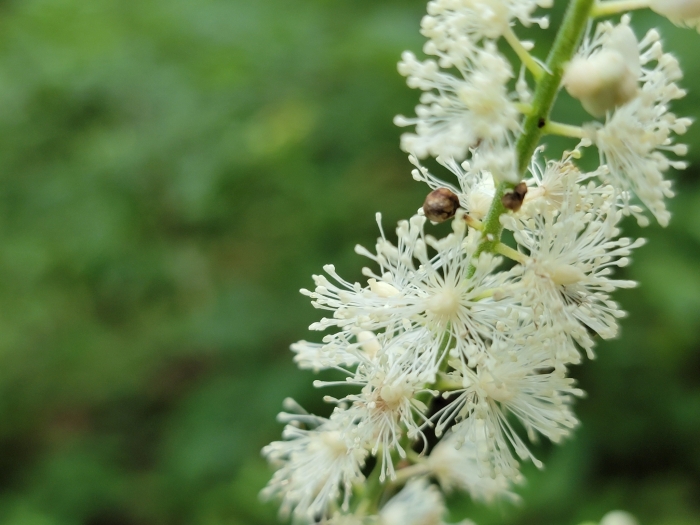Black Cohosh
(Actaea racemosa)
Black Cohosh (Actaea racemosa)
/
/

Elias
CC BY 4.0
Image By:
Elias
Recorded By:
Copyright:
CC BY 4.0
Copyright Notice:
Photo by: Elias | License Type: CC BY 4.0 | License URL: http://creativecommons.org/licenses/by/4.0/ | Rights Holder: Elias | Publisher: iNaturalist | Date Created: 2021-07-10T15:32:45-07:00 |



















































Estimated Native Range
Summary
Actaea racemosa, commonly known as Black Cohosh, is a deciduous perennial herb native to rich, deciduous forests and woodland margins in Eastern North America. It typically grows to a height of 3-5 feet and a width of 2-4 feet. The plant is characterized by its tall, compound leaves and a striking, elongated raceme of white flowers that bloom in late spring to early summer. The flower racemes can reach up to 50 cm (20 in) in length, with numerous small white stamens surrounding a central stigma, creating a bottlebrush effect. Despite having no petals or sepals, the flowers are quite showy due to their dense arrangement and size. The flowers emit a strong, sweet yet slightly fetid odor that attracts pollinating insects such as flies, gnats, and beetles.
Black Cohosh is valued for its architectural form and the contrast provided by its dark, wiry stems against the frothy white flowers. It is often used in shaded garden settings, woodland gardens, and naturalized areas. The variety ’Atropurpurea’ offers additional interest with its burgundy-colored foliage. This plant is recognized for its ornamental value and has been awarded the Royal Horticultural Society’s Award of Garden Merit. Cultivation requires consistently moist, fertile soil with good organic content. Black Cohosh thrives in part shade to full shade and benefits from medium water availability and medium soil drainage. While generally low-maintenance, it can suffer from leaf spot and snail or slug damage. It is also important to note that Black Cohosh should not be consumed without proper guidance due to its potent medicinal properties, which can have adverse effects if misused.CC BY-SA 4.0
Black Cohosh is valued for its architectural form and the contrast provided by its dark, wiry stems against the frothy white flowers. It is often used in shaded garden settings, woodland gardens, and naturalized areas. The variety ’Atropurpurea’ offers additional interest with its burgundy-colored foliage. This plant is recognized for its ornamental value and has been awarded the Royal Horticultural Society’s Award of Garden Merit. Cultivation requires consistently moist, fertile soil with good organic content. Black Cohosh thrives in part shade to full shade and benefits from medium water availability and medium soil drainage. While generally low-maintenance, it can suffer from leaf spot and snail or slug damage. It is also important to note that Black Cohosh should not be consumed without proper guidance due to its potent medicinal properties, which can have adverse effects if misused.CC BY-SA 4.0
Plant Description
- Plant Type: Herb
- Height: 3-5 feet
- Width: 2-4 feet
- Growth Rate: Moderate
- Flower Color: Cream, White
- Flowering Season: Summer
- Leaf Retention: Deciduous
Growth Requirements
- Sun: Part Shade, Full Shade
- Water: Medium
- Drainage: Medium
Common Uses
Bee Garden, Bird Garden, Border Plant, Butterfly Garden, Deer Resistant, Erosion Control, Fragrant, Hummingbird Garden, Rabbit Resistant, Showy Flowers, Street Planting
Natural Habitat
Rich, deciduous forests and woodland margins in Eastern North America
Other Names
Common Names: Black Snakeroot, Black Bugbane, Fairy Candle, Cimicaire À Grappes, Läkesilverax
Scientific Names: , Actaea racemosa, Cimicifuga racemosa, Actaea racemosa var. racemosa, Actaea ramosa, Cimicifuga americana, Cimicifuga serpentaria, Actaea gyrostachya, Actaea monogyna, Actaea orthostachya
GBIF Accepted Name: Actaea racemosa L.